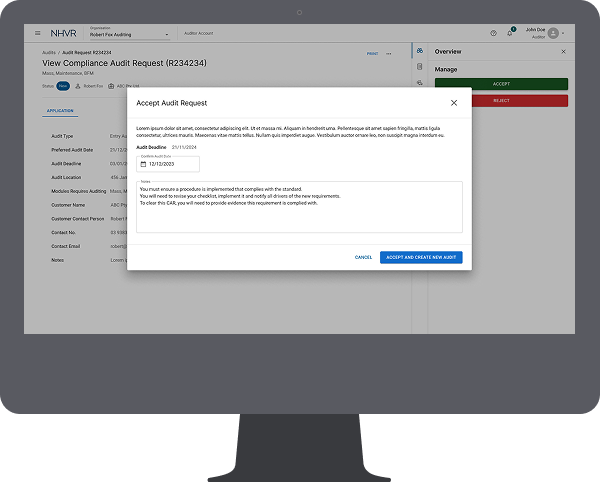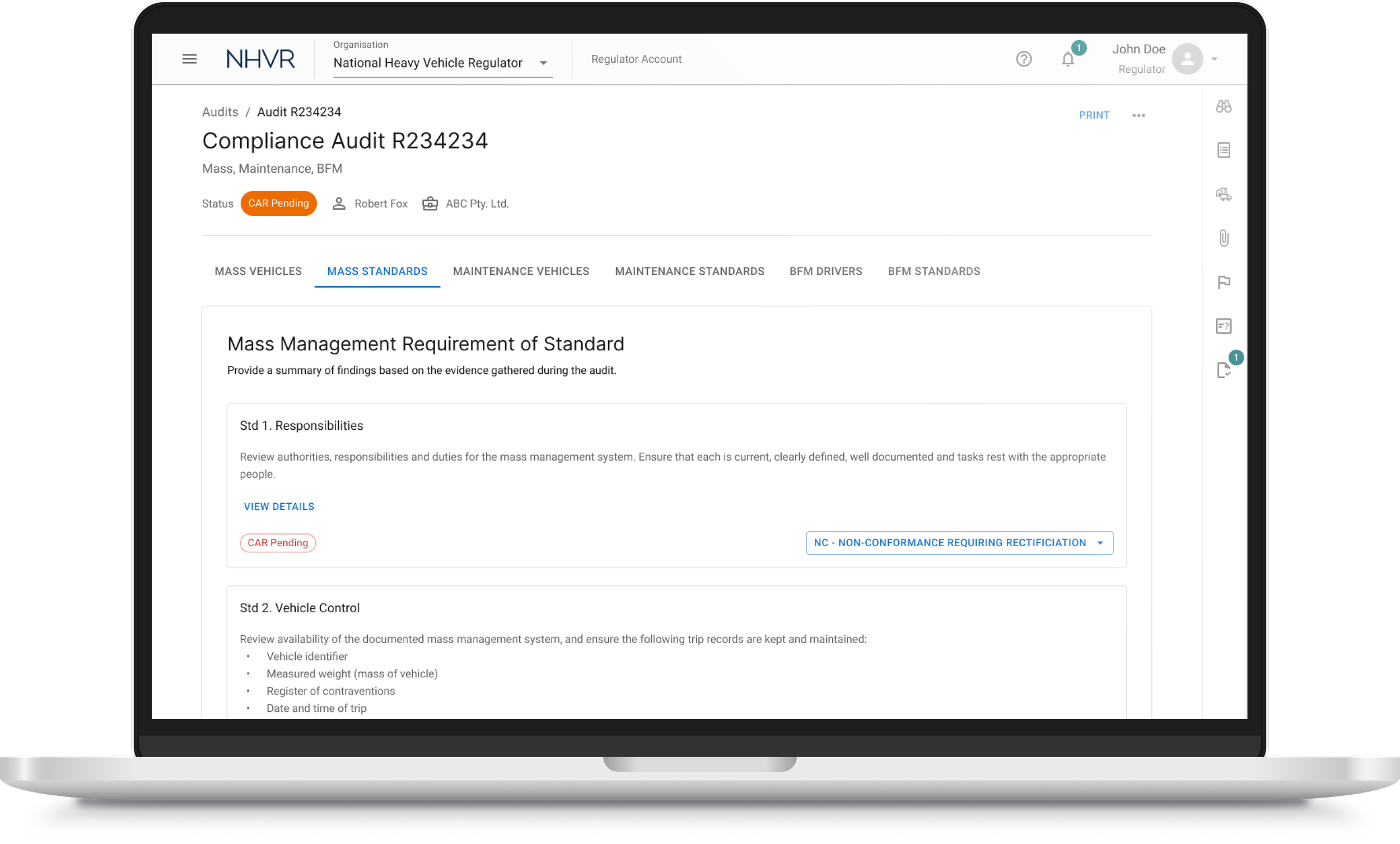Streamlining Compliance: Digitising the NHVAS Audit Process
Project Overview
The NHVR’s auditing process was plagued by inefficiencies, including a confusing onboarding experience, frequent submission errors, and fragmented systems. Sole traders struggled with account setup, auditors faced high rejection rates due to inconsistent data capture, and regulators were burdened with manual oversight.
The lack of integration between the LMS, certification processes, and audit workflows further weakened audit integrity and slowed compliance monitoring.
Role
As a senior UX design consultant, my role involved close collaboration with the design director, product owner and business analysts. My core responsibilities included defining the user journey, conducting comprehensive research, developing initial wireframes, conducting user testing and creating high resolution interfaces.
Approach
To address these issues, we applied a user-centred design methodology grounded in deep research and iterative testing. We mapped the auditor and operator journeys end-to-end, conducted interviews to uncover pain points, and validated prototypes with real users. Insights revealed that onboarding confusion, inconsistent workflows, and system fragmentation were core contributors to errors and inefficiencies.
Process & Methodology
1.1
Discovery & Research:
Research Goals
Uncover the end to end user journey for heavy vehicle operators and fleet managers in the auditing process.
Understand user needs and expectations regarding auditing processes and requirements.
Identify key use cases for a digital audit tool & validate the value of such a project.
Evaluate the usability of different approaches to auditing.
Explore auditor preferences for scheduling, managing, conducting and submitting audits.
1.2
Discovery & Research:
Research Methods
User Interviews: Ongoing interviews were conducted with auditors and various NHVR accreditation team members. This allowed us to create an indepth journey map of the auditing process, while gathering insights on processes, needs and pain points.
Contextual Inquiry: Observed various user types (regulator staff & external auditors) in real-world scenarios to identify and understand the challenges they face.
Stakeholder Workshops: Facilitated workshops with stakeholders to align on project goals, identify requirements, and explore potential solutions.
1.3
Discovery & Research:
Research Findings
The current account creation and audit submission processes for auditors in the transportation compliance system are inefficient, error-prone, and lack standardisation, leading to frequent submission rejections.
Frequent audit submission issues result in increased workload for regulatory bodies, delays in the audit process, and potential oversights in compliance monitoring.
These issues arose from the following:
A complex and unclear account creation process, particularly for sole traders and different regulatory bodies (NHVR and Western Australia).
Inconsistencies in how business-level and individual-level information is captured and managed during onboarding.
Lack of integration between the Learning Management System (LMS) and the main onboarding flow.
Absence of a streamlined process for attaching certifications and managing permissions.
High frequency of errors in audit submissions, including incorrect audit types, invalid business information, and discrepancies in vehicle and driver summaries.
Potential for compromised audit integrity due to the financial relationship between auditors and operators.
Inconsistent practices in raising and managing Corrective Action Requests (CARs).
Absence of real-time validation for critical information such as business names, operator numbers, and audit dates.
Lack of clear guidance on handling specific scenarios like subcontractors and fatigue management exemptions.
2.1
Developed user flows to map out the steps involved in various auditing scenarios:
Operators requesting various types of audits under different scenarios.
Auditors scheduling and conducting Audits.
Regulator review and approval of audits.
Design Process:
User Journey Flow
2.2
Creation of extensive low resolution wireframes and interactive prototypes to visualise the user interface and user experience of all touchpoints within the auditing process.
Design Process:
Wireframing
2.3
Hi-resolution designs were created in Figma utilising NHVR’s custom design system.
Design Process:
UI Design
3.1
Testing & Iteration:
Usability Testing
Usability Testing: Usability testing sessions were conducted with target users to evaluate the design of the many features and touch points of the digital auditing tool.
Testing Objectives:
Evaluate the ease of account creation for auditors.
Assess the consistency and clarity of information capture
Identify and address sources of errors in audit submissions.
Identify areas where additional guidance or functionality is needed.
Evaluate the clarity and effectiveness of the audit process.
Identify any pain points or usability issues in the user flow.
Gather qualitative feedback on overall user experience.
3.1
Testing & Iteration:
Design Iteration
Testing results and findings guided design iterations where possible within scope. Some major iterations involved:
Improving the clarity of information such as criteria helper text, descriptions and error messages.
Creating a separate task flow for Operators and Regulators carrying out Corrective Action Requests.
Optimising UI for tablet devices.
Creating a more prominent declaration process for both Auditors and Operators.
Results and Impact
Through user-centred design and the adoption of a robust design system, we delivered an end-to-end auditing tool that not only improved efficiency and accuracy but also strengthened compliance integrity across the transport industry.
Streamlined Onboarding
A guided, simplified account creation process reduced registration errors and minimised support requests. Sole traders and businesses could now complete setup with confidence and clarity.
Error-Resistant Submissions
Built-in real-time validation, contextual guidance, and standardized workflows lowered audit rejection rates, accelerating approvals and improving compliance accuracy.
Integrated Compliance Ecosystem
By consolidating the certification management, work flow and permissions into a single dashboard, we reduced duplication, improved transparency, and significantly lightened the administrative load on regulators.




